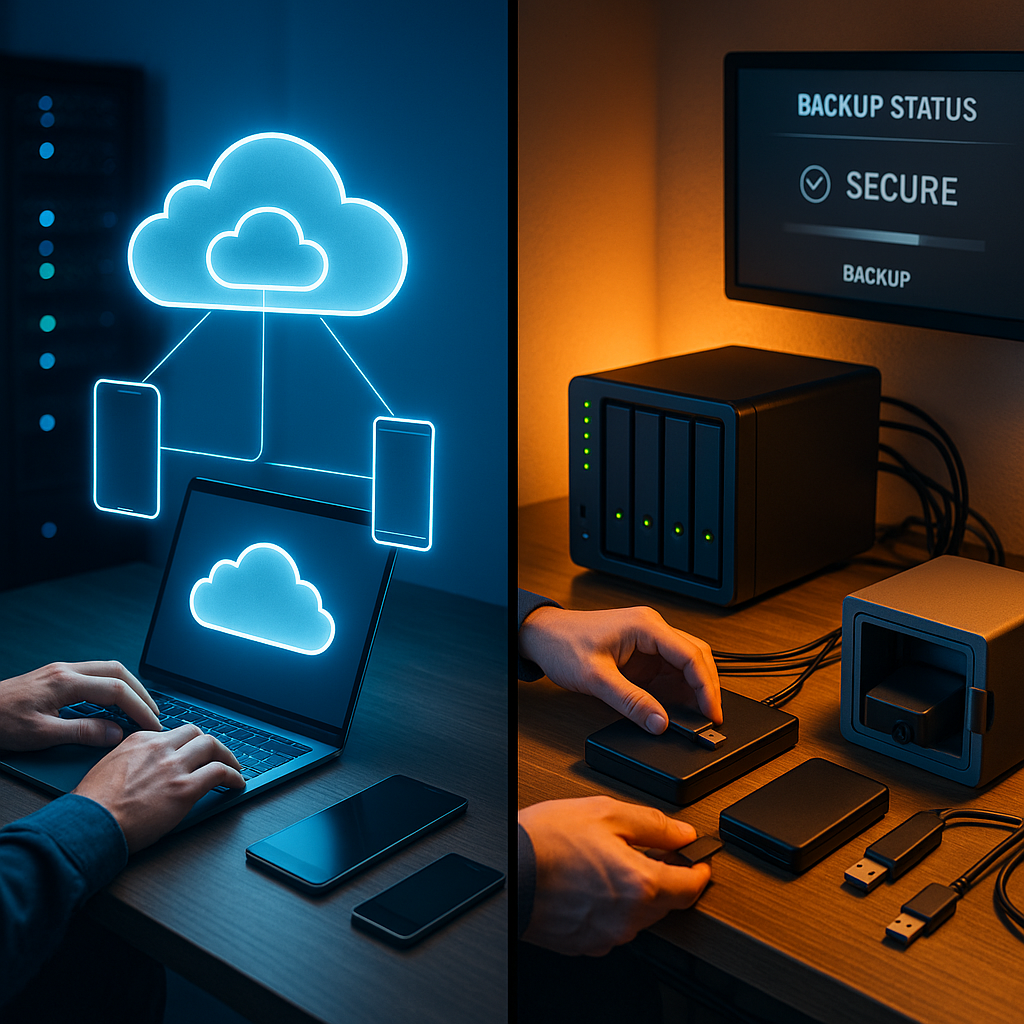Key Takeaways
In the debate between cloud and local storage, everyday users share the same top concerns as businesses: data safety, control, and genuine peace of mind. Choosing a storage solution goes far beyond technical details, touching on convenience, cost, risk recovery, and even the psychological comfort of knowing your data is safe. Here’s what you need to know to make an informed decision.
- Recognize security trade-offs: Cloud storage benefits from advanced encryption and expert-managed defenses, but the online nature of the cloud means potential cyber threats. Local storage, by contrast, places your files under your physical control and beyond online reach, yet can be compromised by device failure or theft.
- Maximize convenience with the cloud: Storing files in the cloud means instant access from nearly any device, anywhere, no manual transfers or cables required. Local storage keeps you tethered to specific hardware and relies on you to move or back up files.
- Weigh hidden costs carefully: While cloud subscriptions may look inexpensive at first, long-term fees and scaling needs can add up. Local storage is a one-time purchase, but expect possible future costs for upgrades, extra drives, or professional recovery.
- Cloud excels in disaster recovery: Leading cloud services offer redundant, regionally dispersed backups and robust recovery features, shielding your data from fire, flood, or accidental deletion. Local-only solutions are more vulnerable if hardware is lost or destroyed.
- Understand the control-convenience balance: Cloud providers handle updates, backups, and most security, though this means entrusting your data to a third party. Local storage provides unrivaled control and privacy, but requires you to manage all safety and maintenance tasks.
- Address storage anxiety through a blended approach: The stress of choosing between seemingly perfect opposites (convenience or control) can be overwhelming. Many users find combining both (hybrid storage) delivers the greatest peace of mind: locally back up your most sensitive or irreplaceable files, while letting the cloud boost accessibility for everyday needs.
- No universal answer. Align storage with your priorities: If total control and privacy are essential, secure local drives shine. For effortless collaboration and backup, cloud solutions are unbeatable. Often, backing up core files locally while using the cloud for flexibility hits the sweet spot for both protection and convenience.
Armed with these practical takeaways, you can evaluate storage options with confidence. Next, let’s break down key features, possible risks, and actionable tips for both cloud and local storage so you can tailor the best strategy for your data, whether you’re managing family photos, business documents, or sensitive healthcare records.
Introduction
Uploading your photos or important documents to the cloud feels reassuringly efficient. Then you pause to consider who else might peek at them or how quickly you could recover them if disaster struck. The choice between cloud and local storage is more than a technical question; it’s a decision about trust, convenience, security, and long-term peace of mind for your most valuable digital possessions.
Knowing the strengths and trade-offs of each storage approach is essential. Cloud storage puts your files within reach any time and safeguards them with strong redundancies, but also invites questions about privacy, surveillance, and escalating costs. Local storage gives you complete physical control, allowing offline access in sensitive environments, yet brings its own set of vulnerabilities, such as hardware failures or theft.
Un passo avanti. Sempre.
Unisciti al nostro canale Telegram per ricevere
aggiornamenti mirati, notizie selezionate e contenuti che fanno davvero la differenza.
Zero distrazioni, solo ciò che conta.
 Entra nel Canale
Entra nel Canale
As our reliance on digital data expands across personal, professional, and even healthcare or educational domains, understanding these differences can stave off future headaches. Take this journey with us as we examine the facts, compare practical pros and cons, and offer guidance on finding a storage solution that protects your files and your confidence.
Security Comparison: Cloud vs Local Storage
Security remains the single biggest differentiator in the cloud versus local storage conversation, influencing everything from family photo management to clinical record retention and legal document archiving.
Cloud providers invest heavily in advanced security controls, leveraging technologies such as 256-bit AES encryption, multi-factor authentication, and around-the-clock monitoring by experienced cybersecurity professionals. These measures are bolstered by routine security audits, threat detection systems, and rigorous compliance standards, including those relevant in finance, healthcare, and education.
Local storage, on the other hand, puts you squarely in the driver’s seat. When properly configured, a home storage device with strong encryption and up-to-date firmware can provide excellent data protection. The catch? Many users neglect essential steps, such as regular updates, secure passwords, or backup redundancy, leaving their data more exposed than they realize.
Key Security Features Comparison
-
Cloud Storage:
-
Automatic encryption in transit and at rest
-
Frequent security audits and swift patch management
-
Ransomware mitigation via file versioning
-
Geographic redundancy for disaster resistance
-
Ongoing monitoring by specialist teams
-
Compliance with strict industry standards (especially crucial for healthcare, legal, and finance sectors)
-
Local Storage:
-
Full physical access control (files are only accessible to you and those you permit)
-
No exposure to internet-based attacks when drives stay offline
-
Opportunity to use custom encryption tailored to personal requirements or industry needs
-
Security protocols and updates dictated by the user, not by a third party
-
Useful for storing sensitive corporate, legal, or clinical data, especially where regulations require on-premises or air-gapped solutions
The question “Is cloud storage less secure than local?” has no simple answer. Well-managed cloud storage from a reputable provider generally offers better raw security than a poorly configured home solution and meets strict requirements for sectors like finance or healthcare. However, expertly set-up local storage can rival or even surpass cloud setups for privacy and control, assuming the user diligently maintains security best practices, including off-site backups.
Accessibility and Convenience
The shift toward cloud storage has been fueled largely by its promise of universal accessibility. This is a defining advantage for remote work, collaborative education, swift patient record access in healthcare, and on-the-go customer service in retail.
Cloud platforms enable seamless cross-device synchronization, so a photo snapped on your phone is instantly viewable on your laptop or shared with family members within moments. Work documents, medical imaging files, lesson plans, or contracts can be edited in real time, with versioning and rollback options for when things go wrong. Secure sharing links and remote collaboration tools are now standard across industries.
Real-World Accessibility Scenarios
- Remote Work and Healthcare: Cloud systems allow employees, medical professionals, or teachers to access critical data across locations, whether reviewing patient charts from home, editing legal drafts remotely, or teaching a lesson via a shared presentation.
- Family Moments and Student Collaboration: Cloud storage transforms photo sharing and group projects, allowing families or classmates to access and update albums or assignments without the friction of physical transfers.
- Retail and Small Businesses: Inventory updates or sales data can be accessed and adjusted in real-time, even from mobile devices or distant storefronts. Local-only storage would severely limit this agility.
For local storage users, accessing files remotely typically demands advanced setup: VPNs, remote desktop software, or manually transporting drives. Convenience can be achieved, but usually with more technical effort and risk.
Leading cloud services now pair convenience with serious security, using biometric authentication, secure invitation links, and granular permissions to mitigate privacy risks.
Cost Considerations
A side-by-side cost analysis reveals important subtleties in the total expense of each storage solution, especially as data needs scale across family, business, or research uses.
Cloud Storage: Subscription-based models mean predictable monthly or yearly payments. Small allocations (a few gigabytes) are often free, but as you accumulate high-resolution photos, project archives, or raw research data, costs rise. Additional expenses may include bandwidth charges for large transfers and extra fees for advanced compliance (essential in legal or healthcare sectors).
Local Storage: Hardware costs are upfront. Think robust external drive, NAS device, or even enterprise-grade backups in a professional setting. Over time, you should also budget for backup media, hardware replacements, electricity consumption, and potential data recovery services. While large capacity drives are increasingly cost-effective per gigabyte, safeguarding against failure may require duplicate devices or off-site rotation for disaster protection.
Comparative Cost Analysis
-
Cloud Storage:
-
Pay-as-you-grow for scalability (ideal for evolving needs in business, education, or healthcare research)
-
Annual costs for 1TB: typically $60-$120, suitable for most personal or small business users
-
Minimal maintenance hassle (no physical device worries)
-
Local Storage:
-
One-time investment: $200-$400 for quality drives or an entry-level NAS
-
Ongoing backup/maintenance: cost and time for upgrades, plus potential charges for expert recovery
-
Greater initial outlay but no recurring fees, ideal for predictable, long-term storage
Calculating true value means factoring not just immediate expense, but also convenience, risk tolerance, and the cost (emotional and financial) of possible data loss or legal noncompliance.
Data Recovery and Disaster Planning
Another critical consideration, often overlooked until there’s a problem, is how quickly and reliably you can recover lost or corrupted data. From sudden hard drive failures to devastating events like fire, flood, or ransomware, disaster recovery plans determine whether your data is truly safe.
Cloud Providers: Industry-leading platforms keep multiple copies (often in separate geographic regions), enabling quick file restores and sometimes granular point-in-time recovery. Healthcare organizations, financial institutions, and academic researchers often depend on this level of reliability, as do everyday users wanting peace of mind for family memories.
Local Storage: Recovery is only as good as your backup discipline. While some users manually duplicate data across drives, full protection means maintaining at least one backup offsite, which is often skipped due to inconvenience. Versioning and built-in recovery tools can be implemented but require technical know-how and, ideally, regular testing.
Un passo avanti. Sempre.
Unisciti al nostro canale Telegram per ricevere
aggiornamenti mirati, notizie selezionate e contenuti che fanno davvero la differenza.
Zero distrazioni, solo ciò che conta.
 Entra nel Canale
Entra nel Canale
Recovery Scenarios and Solutions
- Cloud: Effortless version rolling for accidentally overwritten business documents, fast restore after deleting vital educational or clinical records, professional disaster recovery help during service outages.
- Local: Hands-on drive replacement, possible reliance on paid recovery labs for water-damaged devices, manual checks for backup integrity.
Given the emotional toll of data loss, whether it’s irreplaceable photos, vital legal documents, or archived patient scans, automated cloud recovery often provides a comforting safety net. However, disciplined local backups (especially when combined with offsite rotations or hybrid cloud syncs) can offer similarly robust protection.
For those interested in learning more about the foundational differences and practical implications, see this simple comparison of cloud vs local storage.
Data Ownership, Control, and Peace of Mind
Beyond technical stats, psychological comfort influences the choice between cloud and local storage for families, freelancers, enterprises, and even regulated industries. For some, knowing precisely where data lives (and being able to physically touch the drives) provides unmatched assurance. For others, offloading backups and disaster response to seasoned professionals is worth surrendering some control.
Balancing Control and Convenience
- Hybrid Storage Strategy:
- Store sensitive data (contracts, medical records, proprietary assets) locally, with strong encryption and restricted access. This is ideal for legal firms or healthcare providers.
- Rely on the cloud for everyday files, client deliverables, or collaborative content, supporting efficiency in creative, educational, and business environments.
- Regularly back up critical cloud data to a secure local drive, and maintain encrypted offline copies for ultimate disaster resilience.
- Personal and Professional Safeguards:
- Perform periodic audits of who can access cloud files or local devices. This is crucial for both personal and workplace environments.
- Clarify data classification so you know which files need ironclad privacy, and which can safely reside in the cloud.
- Routinely test your recovery process to confirm you can restore lost data swiftly. This is vital for regulated sectors like healthcare and finance.
By consciously blending control and convenience, you craft a storage plan that adapts to changing circumstances, whether facing regulatory audits, supporting remote learning, or simply safeguarding your family albums.
If managing daily digital routines is a challenge, adopting time-saving tech habits can further boost your tech efficiency and peace of mind.
Conclusion
The ongoing conversation around cloud versus local storage proves there is no universal winner. Instead, there are evolving, personalized strategies that reflect your digital habits and risk tolerance. Cloud storage stands out for seamless accessibility, set-and-forget backups, and enterprise-level security, making it a game-changer for users prioritizing flexibility and hands-off maintenance, from small business owners to busy parents and telehealth providers.
Meanwhile, local storage empowers those who demand strict privacy assurances, regulatory compliance, or direct physical oversight. It’s ideal for legal teams, healthcare practices, or anyone uncomfortable entrusting sensitive data to a third party.
The future belongs to those willing to thoughtfully blend both worlds. By embracing a hybrid approach, you combine professional convenience with personal control, ensuring your most treasured files are always accessible yet never unprotected. Looking forward, adopting flexible storage strategies, strengthening your recovery protocols, and staying attuned to evolving threats will keep your digital life secure, resilient, and confidently under your command. The real advantage will go to those who not only adopt secure storage solutions, but also continuously refine them, ensuring your data remains both shielded and effortlessly within reach in our dynamic digital age.





Leave a Reply